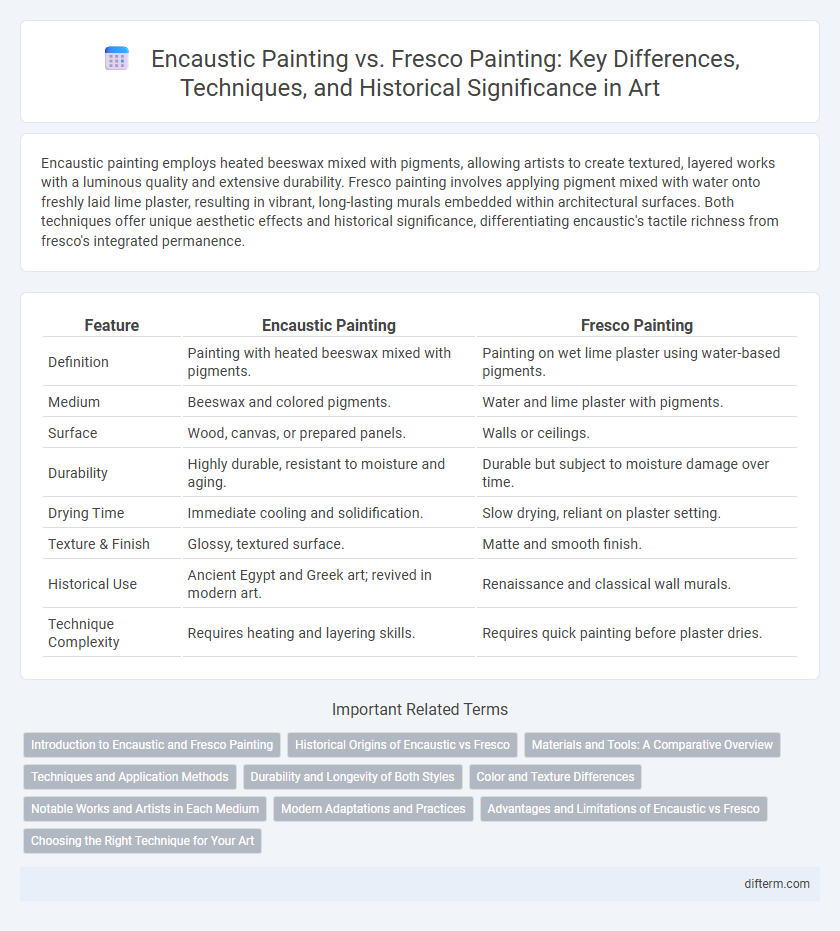Encaustic painting employs heated beeswax mixed with pigments, allowing artists to create textured, layered works with a luminous quality and extensive durability. Fresco painting involves applying pigment mixed with water onto freshly laid lime plaster, resulting in vibrant, long-lasting murals embedded within architectural surfaces. Both techniques offer unique aesthetic effects and historical significance, differentiating encaustic's tactile richness from fresco's integrated permanence.
Table of Comparison
| Feature | Encaustic Painting | Fresco Painting |
|---|---|---|
| Definition | Painting with heated beeswax mixed with pigments. | Painting on wet lime plaster using water-based pigments. |
| Medium | Beeswax and colored pigments. | Water and lime plaster with pigments. |
| Surface | Wood, canvas, or prepared panels. | Walls or ceilings. |
| Durability | Highly durable, resistant to moisture and aging. | Durable but subject to moisture damage over time. |
| Drying Time | Immediate cooling and solidification. | Slow drying, reliant on plaster setting. |
| Texture & Finish | Glossy, textured surface. | Matte and smooth finish. |
| Historical Use | Ancient Egypt and Greek art; revived in modern art. | Renaissance and classical wall murals. |
| Technique Complexity | Requires heating and layering skills. | Requires quick painting before plaster dries. |
Introduction to Encaustic and Fresco Painting
Encaustic painting employs heated beeswax mixed with colored pigments, allowing artists to achieve rich textures and luminous surfaces that endure over time. Fresco painting involves applying water-based pigments onto freshly laid wet plaster, resulting in durable murals that become integral to the wall structure as they dry. Both techniques showcase ancient traditions but differ significantly in materials, methods, and visual effects.
Historical Origins of Encaustic vs Fresco
Encaustic painting, originating in Ancient Egypt around 1000 BCE, utilizes heated beeswax mixed with colored pigments applied to surfaces, preserving vivid colors over millennia. Fresco painting, developed during the Italian Renaissance with roots in antiquity, involves applying pigments onto freshly laid wet lime plaster, allowing the colors to chemically bond as the plaster dries. These distinct historical origins showcase encaustic's durability in funerary art compared to fresco's prominence in monumental architecture and religious murals.
Materials and Tools: A Comparative Overview
Encaustic painting involves heated beeswax mixed with colored pigments, applied using brushes and metal tools to manipulate texture and layering. Fresco painting employs water-based pigments on wet lime plaster, requiring trowels and sponges to blend and smooth colors seamlessly. The distinct materials dictate different drying times and surface interactions, crucial for artists' technique and preservation.
Techniques and Application Methods
Encaustic painting involves heating beeswax mixed with colored pigments and applying it in layers using brushes or heated tools, allowing for rich texture and depth. Fresco painting requires applying pigments mixed with water onto freshly laid wet lime plaster, enabling the colors to chemically bond with the wall surface for durability. Encaustic allows for more sculptural effects and revisions, whereas fresco demands precise timing and swift execution to capture the intended image.
Durability and Longevity of Both Styles
Encaustic painting, created by applying heated beeswax mixed with pigments, exhibits exceptional durability due to its water-resistant and flexible surface, enabling it to withstand environmental changes for centuries without significant degradation. Fresco painting, executed by applying pigment onto freshly laid lime plaster, offers remarkable longevity as the pigments chemically bond with the plaster, resulting in a durable, integrated artwork that can last millennia when protected from moisture and structural damage. Both techniques showcase unique preservation qualities, with encaustic excelling in climate resilience and frescoes providing unparalleled structural permanence in architectural contexts.
Color and Texture Differences
Encaustic painting utilizes heated beeswax mixed with colored pigments, resulting in vibrant, lustrous colors and a textured, glossy surface that can be built up in layers. Fresco painting involves applying pigment onto wet lime plaster, producing matte, muted colors with a smooth, integrated texture as the pigment chemically bonds with the wall. The permanence of fresco contrasts with the rich tactile quality and color depth of encaustic, making each technique distinct in visual and textural presentation.
Notable Works and Artists in Each Medium
Encaustic painting, renowned for its luminous texture and durability, finds prominence in the Fayum mummy portraits, with artists like Rufus and Dioscorides exemplifying this ancient medium. Fresco painting showcases monumental works such as Michelangelo's Sistine Chapel ceiling and Giotto's Scrovegni Chapel frescoes, illustrating its significance in Renaissance and medieval art. Both techniques highlight distinct artistic traditions and have influenced notable artists and masterpieces across different eras.
Modern Adaptations and Practices
Modern encaustic painting incorporates mixed media and digital tools, enhancing texture and luminosity while preserving traditional wax-based techniques. Fresco painting adapts through contemporary pigments and portable murals, enabling artists to experiment with scale and public engagement in urban spaces. Both methods embrace innovation, merging historical craftsmanship with present-day artistic expression.
Advantages and Limitations of Encaustic vs Fresco
Encaustic painting offers vibrant, durable colors and a versatile surface adaptability thanks to its wax-based medium, which resists moisture and aging better than fresco's lime plaster. Fresco painting excels in large-scale mural applications and longevity within architectural contexts, but it requires rapid execution and extreme skill to apply pigments before plaster dries, limiting flexibility. While encaustic allows for texture manipulation and layering, fresco's permanence can suffer from environmental degradation and is less amenable to corrections after drying.
Choosing the Right Technique for Your Art
Encaustic painting offers vibrant color retention and durability through heated beeswax mixed with pigments, making it ideal for textured, layered art with a luminous finish. Fresco painting, utilizing pigment applied on wet lime plaster, ensures long-lasting, matte surface integration, perfect for large-scale murals and architectural works. Selecting between encaustic and fresco depends on desired visual effects, surface compatibility, and project scale, balancing permanence with aesthetic intent.
encaustic painting vs fresco painting Infographic

 difterm.com
difterm.com